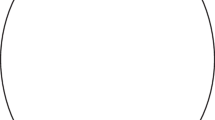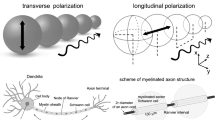Abstract
It is shown in a mathematical model of a myelinated nerve fiber that the development of a local response in an inexcitable node plays an important role in the mechanism of the "jumping" of an action potential (AP) across the inexcitable node. In the absence of such a response (for example, in the case of a 1000-fold decrease in the maximum sodium permeability,\(\bar P\) Na) in fibers with normal relations between the length of the internodal segment (L) and its diameter (D) (L/D>100), the conduction is blocked. It is possible only in fibers with relatively short internodal segments (L/D<90). With a decrease in the\(\bar P\) Na in several nodes, the transmission of excitation from the first to the second altered node is of critical importance for propagation of the impulse. The conduction of an AP becomes decremental if in each of the altered nodes the AP acquires a gradual character, for example, in the case of acceleration of sodium inactivation through the rate constant βh.
Similar content being viewed by others
Literature cited
M. B. Berkinblit, "Periodic blocking of impulses in excitable tissues," in: Models of Structural and Functional Organization of Some Biological Systems [in Russian], Nauka, Moscow (1966). pp. 131–158.
N. E. Vvedenskii, "Excitation, Inhibition, and Narcosis," Collection of Papers edited by A. A. Ukhtomskii [in Russian], Vol. 3, Izd-vo LGU (1935).
D. N. Nasonov, Local Reaction of Protoplasm and Propagating Excitation [in Russian], Izd. Akad. Nauk SSSR, Moscow-Leningrad (1959), p. 246.
I. Tasaki, Nerve Impulse Conduction [Russian translation], IL, Moscow (1957), pp. 63, 145.
B. I. Khodorov, E. N. Timin, S. Ya. Vilenkin, and F. B. Gul'ko, "Theoretical analysis of mechanisms of conduction of nerve impulse through nonuniform axon. I. Conduction through segment with increased diameter," Biofizika,14, 304–315 (1969).
B. I. Khodorov, E. N. Timin, S. Ya. Vilenkin, and F. B. Gul'ko, "Theoretical analysis of mechanisms of nerve impulse conduction through nonuniform axon. II. Conduction of single impulse through area of fiber with functionally altered properties," Biofizika,15, 140–146 (1970).
B. I. Khodorov and E. N. Timin, "Theoretical analysis of mechanisms of nerve impulse conduction through nonuniform axon. III. Transformation of rhythms in cooled segment of fiber," Biofizika,15, 503–511 (1970).
J. Cooley and F. Dodge, "Digital computer solutions for excitation and propagation of the nerve impulse," Biophys. J.,6, 583–599 (1966).
R. FitzHugh, "Computation of impulse initiation and saltatory conduction in myelinated nerve fiber," Biophys. J.,2, 11–21 (1962).
B. Frankenhaeuser and A. F. Huxley, "The action potential in the myelinated nerve fiber ofXenopus laevis as computed on the basis of voltage clamp data," J. Physiol. (London),171, 302–315 (1964).
L. Goldman and J. Albus, "Computation of impulse conduction in myelinated fibers: theoretical basis of velocity-diameter relation," Biophys. J.,8, 596–607 (1968).
L. Herman, "Zur theorie der erregunsleitung und der elektrischen. Erregung," Pfl. Arch.,75, 574–590 (1899).
G. Kato, "The theory of decrementless conduction in narcotized region of nerve," Hongo, Tokyo, Japan (1924).
P. Müller, "Effects of external currents on duration and amplitude of normal and prolonged action potentials from single node of Ranvier," J. Gen. Physiol.,42, 163–190 (1958).
R. Stämpfli, "Bau und funktion isolierter markhaltiger nervenfasern.," Ergebn. der Physiol.,47, 70–165 (1954).
J. Uehara, "Graduated nodal response in NaCl-deficient media and the critical NaCl concentration for excitation," Jap. J. Physiol.,9, 304–310 (1959).
B. Werigo, "Zur frage über die Beriehungen zwischen erregbarkeit und leitungsfahigkeit des Nerven," Pfl. Arch. Physiol.,76, 552–607 (1899).
Additional information
A. V. Vishnevskii Institute of Surgery, Academy of Medical Sciences of the USSR, Moscow. Translated from Neirofiziologiya, Vol. 3, No. 3, pp. 316–324, May–June, 1971.
Rights and permissions
About this article
Cite this article
Khodorov, B.I., Timin, E.N. Theoretical analysis of mechanisms of nerve impulse conduction along myelinated fiber after a functional change in the properties of individual nodes. Neurophysiology 3, 237–244 (1971). https://doi.org/10.1007/BF01065499
Received:
Issue Date:
DOI: https://doi.org/10.1007/BF01065499




